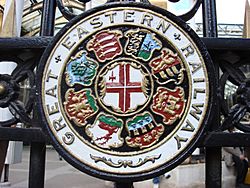Great Eastern Railway facts for kids
 |
|
| Overview | |
|---|---|
| Dates of operation | 1862–1923 |
| Predecessor | Eastern Counties Railway Eastern Union Railway and others |
| Successor | London and North Eastern Railway |
The Great Eastern Railway (GER) was an important British railway company that operated for over 60 years. It was formed in 1862 and served a large area of eastern England, connecting London Liverpool Street to cities like Norwich and many other towns across East Anglia. The GER was known for its busy lines, carrying both passengers and goods. In 1923, it became part of a much larger company called the London and North Eastern Railway.
Contents
What Was the Great Eastern Railway?
The Great Eastern Railway, often called the GER, was created in 1862. It was formed by joining together several smaller railway companies, including the Eastern Counties Railway and the Eastern Union Railway. This merger helped create a more organized and powerful railway network in the east of England.
Connecting London and East Anglia
The main job of the GER was to link London with the eastern counties of England. Its most important route was the Great Eastern Main Line, which ran from London Liverpool Street Station all the way to Norwich. But the GER had many other lines too, spreading out like a spiderweb across East Anglia. These lines connected towns and cities, making it easier for people to travel and for goods like farm produce to be transported to markets.
The railway helped towns grow and made it simpler for people to visit places like the coast. It also played a big part in moving coal, food, and other important supplies around the country.
The End of the Line: Grouping in 1923
After more than 60 years of service, the Great Eastern Railway stopped being an independent company in 1923. This happened because of a new law called the Railways Act 1921. The government decided to combine almost all the smaller railway companies in Britain into just four very large ones. This was done to make the railway system more efficient after World War I.
The Great Eastern Railway joined with several other companies to form the London and North Eastern Railway (LNER). Even though the GER name disappeared, its tracks, stations, and many of its trains continued to be used as part of the new, bigger LNER network.
Images for kids
-
County School, a GER-built junction station (2008)










